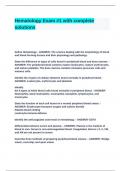Hematology Exam #1 with complete
solutions
Define Hematology - ANSWER- The science dealing with the morphology of blood
and blood forming tissues and their physiology and pathology.
State the difference in types of cells found in peripheral blood and bone marrow. -
ANSWER- The peripheral blood contains mature leukocytes, mature erythrocytes,
and mature platelets. The bone marrow contains immature precursor cells and
matures cells.
Identify the 3 types of cellular elements found normally in peripheral blood -
ANSWER- Leukocytes, erythrocytes and platelets
Identify
the 6 types of white blood cells found normally in peripheral blood. - ANSWER-
Neutrophils, band neutrophils, eosinophils, basophils, lymphocytes, and
monocytes.
State the function of each cell found on a normal peripheral blood smear. -
ANSWER- Erythrocyte-transport oxygen and carbon dioxide
Platelet-blood clotting
Leukocyte-immune defense
Identify the anticoagulant used most in hematology. - ANSWER- EDTA
Differentiate between serum and plasma. - ANSWER- Plasma is the medium of
blood in vivo. Serum is non-anticoagulated blood. Coagulation factors I, II, V, VIII,
and XIII are not present in serum.
Describe three methods of preparing peripheral blood smears. - ANSWER- Wedge
smear, coverslip, and spun smear
,Describe the characteristics of a well-prepared wedge blood smear and recognize
inadequately-prepared smears, and how to correct them. - ANSWER- 2/3-3/4 of
smear, straight/even feather edge, at least 2.5 cm long, margins narrower than
slide, no streak, waves, clumps, or troughs, gradual transition from thick to thin.
Identify zone 1-4 on a peripheral blood smear and the cells that can be examined
in zone 1, 2, and 3. - ANSWER- Zone 1: platelets and WBCs
Zone 2: RBC inclusion, platelets, and WBCs
Zone 3: All cell types
Identify which anticoagulant cannot be used to make blood smears. - ANSWER-
Heparin, because you get a bluish background.
Define Romanowsky stain and list two or three specific types of Romanowsky
stains useful in hematology. - ANSWER- A Romanowsky stain is used to visualize
cellular components. There are three components: Methylene Blue, Eosin, and
Azure B and oxidation products of methylene blue. Two different types of
Romanowsky stains are Wright, Wright-Giemsa Jenner.
Describe the principles of differential staining of cellular constituents by the
various components of Romanowsky dyes - ANSWER- There are three
components: Methylene Blue, which stains acidic components blue
Eosin, which stains the basic components red
Azure B and oxidation products of methylene blue, which occur when the stain
ages.
State the color of the following cellular components with Wright/Giemsa stain:
RNA, mitochondria, Golgi, eosinophil granules, basophil granules, neutrophil
granules, nucleus. - ANSWER- RNA-blue/purple Mitochondria-no stain Golgi-no
stain eosinophil granule-reddish orange basophil granules-purple Neutrophil
granules-purple Nucleus-purple
Reference interval Neutrophil - ANSWER- 1.8-7.0 x 10^9/L
Reference interval band neutrophil - ANSWER- 0-0.7 x 109/L
Reference interval lymphocyte - ANSWER- 1.0-4.8 x 10^9/L
Reference interval monocyte - ANSWER- 0.1-0.8 x 10^9/L
, Reference interval eosinophil - ANSWER- 0-0.4 x 10^9/L
Reference interval Basophil - ANSWER- 0-0.2 x 10^9/L
RBC (erythrocyte) morphologic Characteristics - ANSWER- 7-8 micrometers, no
nucleus, biconcave shape, stain red because of presence of hemglobin
Platelet morphologic characteristics - ANSWER- 2-4 micrometers, no nuclei, have
reddish purple granules
Neutrophil morphologic characteristics - ANSWER- 9-15 micrometers, cytoplasm
uniformly sized pale pinkish to lavender granules (fine sand, glassy) Nucleus-
dark purple color, heavily clumped, 2-5 lobes (3-4 are normal) attached by a fine
filament that has length but no breadth.
Band Neutrophil morphologic characteristics - ANSWER- ame size as neutrophil
(9-15 micrometers), same cytoplasm as neutrophil, nucleus-dark purple heavily
clumped but no segments (horseshoe shaped or s-shaped)
Lymphocyte morphologic characteristics - ANSWER- 7-16 micrometers,
cytoplasm-clear blue, perinuclear zone, color varies from light to dark blue, most
do not show granules. Nucleus-round, oval, or indented dense (smooth)
chromatin, dark staining.
Monocyte morphologic characteristics - ANSWER- 12-20 micrometers, largest cell
in peripheral blood, cytoplasm-abundant, gray-gray/blue, filled with very small
reddish purple granules that are too small to see individually in the microscope.
May have vacuoles. Usually not indented by RBCs. Nucleus-folded or irregular in
shape (horseshoe, lobular), chromatin in strands (fish net, meshwork, stringy,
foamy)
Eosinophil morphologic characteristics - ANSWER- 12-15 micrometers, round,
cytoplasm-refractile or irredescent orange-red granules distributed evenly
throughout cytoplasm. Granules are larger and more uniform in size than
neutrophil granules. Nucleus-usually 2 lobes, sometimes 3 with chromatin.
Basophil morphologic characteristics - ANSWER- 10-15 micrometers, cytoplasm-
large, deep blue, purple to black granules (uneven in size) fewer than eosinophil,
uneven in staining quality. Nucleus-stains lighter than eos or seg. May be
lobulated, usually obscured by granules.




